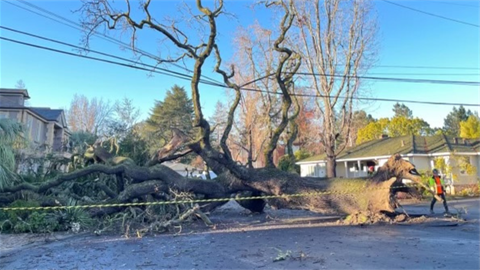Help restore Menlo Park’s urban forest post-storm recovery efforts
Published on May 22, 2023

The city experienced some severe storms a few months ago that significantly impacted the community.To address storm damage to public trees and to ensure the safety of the community, the city has been implementing the steps listed below. Residents should consider taking these measures to maintain their own privately owned trees as well.
1. Assessing Tree Damage: After a storm, it is crucial to assess the damage to trees:
• Safety first: Keep a safe distance from downed power lines, broken branches, or hanging limbs.
• Visual inspection: Examine the tree for broken or damaged limbs, leaning, or uprooted root systems.
• Tree condition: Evaluate the overall health of the tree, checking for decay, disease, or other pre-existing conditions that could compromise stability.
• Seek professional help: If you are uncertain about a tree's health and structure, consult a certified arborist for a comprehensive assessment.
2. Correcting Tree Damage: Once damage has been assessed, implement the following guidelines to address the damage:
• Pruning: Remove broken, damaged, or hazardous branches using proper pruning techniques. Avoid over-pruning, as it can cause additional stress to the tree.
• Structural support: If a tree is leaning or has a weakened structure, cabling or bracing may be necessary to provide support and prevent further damage.
• Tree removal: In some cases, tree removal may be the only option for severely damaged or hazardous trees. Always consult a professional for this process. Heritage tree removal permits are required for the removal of heritage trees in Menlo Park.
• Debris disposal: Properly dispose of fallen branches and debris to ensure the safety of the community and to prevent the spread of disease or pests.
3. Post-Storm Tree Care: To help our urban trees recover, follow these tips:
• Watering: Ensure that trees receive adequate water, especially during periods of drought.
• Mulching: Apply organic mulch around the base of the tree to conserve moisture, moderate soil temperature, and suppress weeds.
• Fertilizing: Consult a professional to determine the appropriate fertilizer and application method for your tree's specific needs.
• Monitoring: Regularly inspect trees for signs of disease, pest infestations, or further damage.
4. Strengthening Our Urban Forests: to build resilience and mitigate the impact of future storms, the city and its residents should consider:
• Diverse species selection: Plant a variety of tree species with different strengths and weaknesses to create a more resilient urban forest.
• Proper planting: Plant trees at the correct depth and spacing to promote healthy root development and reduce the risk of storm damage.
• Proactive maintenance: Regular pruning and tree care can help prevent storm damage and prolong the life of your trees.
Together, you can help restore the city’s urban canopy, ensuring a greener, healthier, and more resilient community for all. For more information or professional assistance on city-owned trees, please submit a service request through the city’s ACT Menlo Park mobile app. For consultation on privately owned trees, contact a local certified arborist. The city has a list of approved consulting arborists if residents are interested in applying for a heritage tree removal permit, but residents may use any local certified arborist for personal use.
Photo credit: David Schwartz